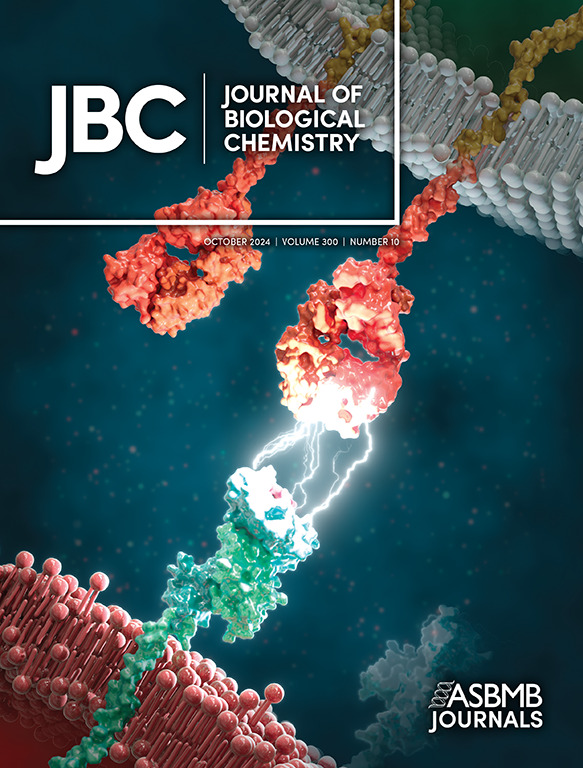水稻木聚糖酶抑制蛋白OsXIP与米根霉GH11木聚糖酶RXyn2结合的分子排列
IF 4
2区 生物学
Q2 BIOCHEMISTRY & MOLECULAR BIOLOGY
引用次数: 0
摘要
植物已经进化出木聚糖酶抑制蛋白作为其防御植物病原体的机制的一部分。水稻木聚糖酶抑制剂蛋白(OsXIP)与GH18几丁质酶结构相似,与小麦木聚糖酶抑制剂(XIP-I)同源,可抑制GH10和GH11木聚糖酶。各种抑制和互作分析表明,OsXIP竞争性地抑制了米根霉GH11木聚糖酶RXyn2的水解活性,而对GH10木聚糖酶RXyn1的水解活性没有抑制作用。OsXIP/RXyn2配合物的晶体结构表明,具有(β/α)8桶褶皱的OsXIP挤出α4和β5之间的环(l - α4β 5osxip),并将该环插入到由RXyn2果冻卷内β-片(掌)形成的木糖结合位点(-3 ~ -1亚位点)。突变分析表明,l - α4β 5osxip中Arg155的胍基对抑制活性至关重要。值得注意的是,在复杂结构中,RXyn2果冻卷掌形成的圆柱形空腔直立堆叠在OsXIP β-链n端环上(I-formation)。另一方面,在Talaromyces funiculosus (XYNC)的XIP-I与GH11木聚糖酶(XYNC)的复合结构中,XYNC的空腔通过l - α4β 5xip - i (T-formation)与XIP-I相应区域的部分切向。OsXIP/RXyn2复合物的解离常数为XIP-I/XYNC复合物的十分之一(分别为4.2 nM和41.5 nM)。OsXIP可能通过改变其结合模式来适应并抑制GH11酶,而GH11酶对xip - 1型蛋白的抑制具有抗性。本文章由计算机程序翻译,如有差异,请以英文原文为准。
Molecular arrangements that accompany binding of rice xylanase inhibitor protein OsXIP and the Rhizopus oryzae GH11 xylanase RXyn2.
Plants have evolved xylanase inhibitor proteins as part of their defense mechanisms against phytopathogens. The rice xylanase inhibitor protein (OsXIP) is structurally similar to GH18 chitinase and homologous to wheat XIP-type inhibitor (XIP-I), which inhibits both GH10 and GH11 xylanases. Various inhibition and interaction analyses showed that OsXIP competitively inhibits the hydrolytic activity of GH11 xylanase RXyn2, but not the activity of GH10 xylanase RXyn1 from Rhizopus oryzae. The crystal structure of the OsXIP/RXyn2 complex showed that OsXIP, which has a (β/α)8-barrel fold, extrudes the loop between α4 and β5 (Lα4β5OsXIP) and inserts the loop into the xylotriose binding site (-3 to -1 subsite) formed by the inner β-sheet (palm) of RXyn2 jelly roll. The guanidyl group of Arg155 in Lα4β5OsXIP was shown to be critical for the inhibitory activity by mutational analysis. Notably, in the complex structure, the cylindrical cavity formed by the palm of RXyn2 jelly roll stacked upright on the loops at the N-terminal ends of the β-strands of OsXIP (I-formation). On the other hand, in the complex structure of XIP-I and GH11 xylanase from Talaromyces funiculosus (XYNC), the cavity of XYNC laid tangentially to the part of the corresponding region of XIP-I through the Lα4β5XIP-I (T-formation). The dissociation constant of the OsXIP/RXyn2 complex was one tenth of that of the XIP-I/XYNC complex (4.2 versus 41.5 nM). OsXIP may have adapted to bind and inhibit GH11 enzymes, which are resistant to the inhibition by XIP-I type proteins, by changing its binding mode.
求助全文
通过发布文献求助,成功后即可免费获取论文全文。
去求助
来源期刊

Journal of Biological Chemistry
Biochemistry, Genetics and Molecular Biology-Biochemistry
自引率
4.20%
发文量
1233
期刊介绍:
The Journal of Biological Chemistry welcomes high-quality science that seeks to elucidate the molecular and cellular basis of biological processes. Papers published in JBC can therefore fall under the umbrellas of not only biological chemistry, chemical biology, or biochemistry, but also allied disciplines such as biophysics, systems biology, RNA biology, immunology, microbiology, neurobiology, epigenetics, computational biology, ’omics, and many more. The outcome of our focus on papers that contribute novel and important mechanistic insights, rather than on a particular topic area, is that JBC is truly a melting pot for scientists across disciplines. In addition, JBC welcomes papers that describe methods that will help scientists push their biochemical inquiries forward and resources that will be of use to the research community.
 求助内容:
求助内容: 应助结果提醒方式:
应助结果提醒方式:


